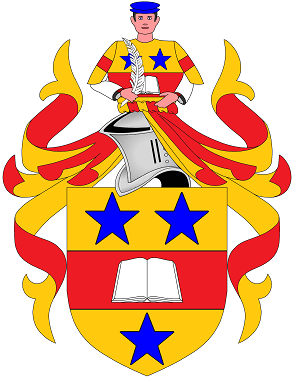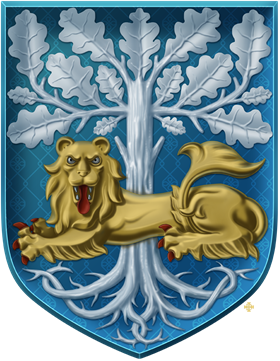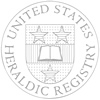U.S. Heraldic Registry
Registration of contemporary and historical American heraldry
Blazon
Definition
The word blazon is derived from Old French blason, meaning "shield", and is a technical description of a coat of arms using correct heraldic terminology. The blazon should be concise (originally to allow heralds to list as many as possible on the page) and not overly verbose. However, blazons should also be specific enough that an artist could create an accurate picture of the arms. This heraldic picture is correctly known as an emblazonment. Similarly, the act of creating that artwork is called emblazoning. All emblazonments of a coat of arms, even if they differ from one another, are the same coat of arms if the blazon is consistent.
How to Blazon
James Parker, in his Glossary of Terms Used in Heraldry, described the order to which a blazon should follow. In summary:
- Describe the FIELD first. Either the tincture (color) or its divisions (per fess, per pale, quarterly, etc.), any patterns (Checquy, Bendy, Fretty, etc.), or semé (strewn with several small charges). When describing the field, the tincture or tinctures must always be named.
- Describe the principal ORDINARY next.
- Any CHARGES on the field that the ordinary is placed between.
- Order of charges named is chief to base and dexter to sinister.
- If there is no ordinary, the principal charge (the largest or center) should be named first. If a charge's position is not specified, its default position is in the center of the shield.
- Any other charges should be named next, along with their relative location and tincture.
- If not otherwise specified, the default position for three charges is two above one.
- Many charges have certain "default" or natural positions and poses. If not otherwise described, the charge must be emblazoned in that position, otherwise the position and attitude of the charge must be blazoned.
- Any charges on the ordinary or another charge.
- Any BORDURE and charges thereon.
- Any CANTON and/or CHIEF and their charges.
- Any DIFFERENCES or marks of cadency or other augmentations.
Other general rules that Parker points out are:
- Avoid repetition when possible.
- If several charges in a row are the same tincture, it is unnecessary to repeat the tincture after each charge. Include the tincture for consecutively named charges after the group.
- Conciseness is desired, but it must be clear and unambiguous.
- Charges should always face the dexter side of the shield unless otherwise blazoned.
Examples

|
The United States Heraldic Registry Arms: Or on a fess Gules between three mullets Azure an openbook Argent.
Crest: A demi-herald vested in and a herald's tabard of the arms and a Tudor Bonnet Azure grasping in his dexter hand a quill pen Argent.
|

|
Celebrate Heraldry - International Heraldry Day Arms: Azure an oak tree erased Argent surmounted by a lion couchant guardant Or.
|
